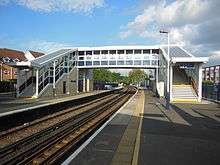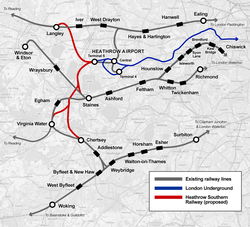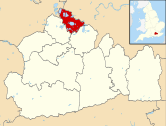Staines railway station
Staines railway station is on the Waterloo to Reading line and is the junction station for the diverging Windsor line, in southern England to the west of London. It is 19 miles 2 chains (30.6 km) down the line from London Waterloo.
| Staines | |
|---|---|
Staines | |
| Location | |
| Place | Staines-upon-Thames |
| Local authority | Spelthorne |
| Grid reference | TQ042714 |
| Operations | |
| Station code | SNS |
| Managed by | South Western Railway |
| Number of platforms | 2 |
| DfT category | C2 |
| Live arrivals/departures, station information and onward connections from National Rail Enquiries | |
| Annual rail passenger usage* | |
| 2014/15 | |
| 2015/16 | |
| 2016/17 | |
| 2017/18 | |
| – Interchange | |
| 2018/19 | |
| – Interchange | |
| History | |
| Key dates | Opened 22 August 1848 |
| National Rail – UK railway stations | |
| * Annual estimated passenger usage based on sales of tickets in stated financial year(s) which end or originate at Staines from Office of Rail and Road statistics. Methodology may vary year on year. | |

History
The station was opened on 22 August 1848 by the Windsor, Staines and South Western Railway, as part of its line from Richmond to Datchet. The line was further extended from Datchet to Windsor & Eton Riverside on 1 December 1849, by which time the Windsor, Staines and South Western Railway had become part of the London and South Western Railway (LSWR). The junction at Staines, together with the line to Wokingham was authorised in 1853 and built by the Staines, Wokingham and Woking Junction Railway, opening as far as Ascot on 4 June 1856 and onwards to Wokingham on 9 July 1856. From the outset, the line was leased to, and operated by, the LSWR, who purchased it outright in 1878. From Wokingham, LSWR trains continued to Reading Southern using running powers over the South Eastern Railway (SER).[1][2][3][4]
In the grouping of railways in 1923, the LSWR and SER became part of the Southern Railway. In 1930 the Windsor line was electrified on the third rail system at a nominal 660 volts DC. The line towards Reading was electrified as far as Virginia Water in 1937, and throughout by 1939.[2]
The Southern Railway was nationalised along with the rest of the railway network in 1948 and incorporated into British Railways. Following the privatisation of British Rail in the 1990s, the operation of Staines station and the trains serving it were transferred to the South West Trains train operating company, owned by the Stagecoach Group, whilst ownership and management of the track and infrastructure passed to Railtrack and, subsequently, Network Rail.
A refurbishment of the station was completed in November 2008 with ticket barriers on the platforms and a renovated ticket office. Wheelchair access to the platforms was provided by a new footbridge with lifts.
Setting and previous name
The station serves the town of Staines-upon-Thames in Surrey in southern England to the west of London and is a pre-junction/junction station for the diverging Windsor line.[n 1] The Windsor Line, a branch of the longer route to Reading laid out as the original destination for the lines from London via Staines, is due to quirk of naming conventions in the rail sector, rarely referred to as a branch line. Both lines are traditionally referred to as "the Windsor Lines" and the passenger lobby group influencing the service pattern of the lines is named the Windsor Lines Passenger Group.[n 2] The station is managed by South Western Railway on a contract awarded by recurring private franchise, who continue passenger services to/from London Waterloo as since the middle of the 20th century to Reading, Windsor & Eton Riverside and Weybridge.
The station was one of three – the others were Staines High Street, on the Windsor line, and Staines West, the terminus of a defunct branch of a main west-facing route from West Drayton to the north. To distinguish it from the others during their existence the station was known as Staines Central, Staines Junction and Staines Old.[5][6]
Operation
Layout
Staines railway station is a conventional (double-track) railway, immediately east of the junction of the Windsor and Reading lines, having converged. It has two flanking platforms, with the main station entrance and buildings on the northern platform 1, and a secondary entrance and buildings on the southern platform 2.
The two platforms are linked by two footbridges, one at each end of the station. The older western bridge is accessed by stairs. The newer eastern bridge has stairs and lifts to make it wheelchair accessible.There are toilets on Platform 2.
Services
Staines railway station is served by South Western Railway services from London Waterloo to Windsor, Reading and Weybridge. Off-peak, each of these services operates two trains per hour, combining to provide six trains per hour from Staines to Waterloo (four are limited stop via Richmond, the other two are all stations via Brentford). Some early morning & late night services start or terminate here and there are additional weekday peak period trains on the Reading line and to/from Aldershot.[7]
On Sundays, there is an hourly stopping service on the line via Brentford - this runs to/from Woking rather than Weybridge. The Reading & Windsor lines still run half-hourly.
Trains to Waterloo stop at platform 1 and trains from Waterloo stop at platform 2.
| Preceding station | Following station | |||
|---|---|---|---|---|
| Feltham | South Western Railway Waterloo to Reading |
Egham | ||
| Ashford or Terminus |
South Western Railway Windsor Line |
Wraysbury | ||
| South Western Railway Waterloo to Chertsey via Hounslow |
Egham | |||
| Historical railways | ||||
| Feltham | Anglia Railways London Crosslink |
Woking | ||
Connections
Staines station is 0.4 mi (0.64 km) south-east of Staines town centre. The two are linked by a walking route that first parallels the Windsor line to the north-west, before passing under the line near the site of the former Staines High Street station.
The 950 Thorpe Park Express bus link runs between the front of the station and the nearby Thorpe Park theme park. London Buses route 117 and 290 have stops 50m north of the station. Other buses operate from the bus station accessed via a broad archway and surface car park from the path to the town centre.
Service expansion schemes
Steam revival locomotive calling point
Since the early 2000s British Summer Time excursions, mainly at weekends, are driven by luxury steam locomotives calling at Staines for day-trip tours of towns and tea room villages in or including Bath, other parts of Somerset, Dorset, west Wiltshire, Devon, Winchester and Salisbury. Permitted operators are the spot-hire companies British American Railway Services, Europhoenix, Harry Needle Railroad Company, MiddlePeak Railways,[8][9] Nemesis Rail, Rail Operations Group, Riviera Trains, UK Rail Leasing, and West Coast Railways.
Additional route and track proposals

Since 2000, a number of transport proposals have been put forward to improve rail connections with Heathrow Airport. The Heathrow Airtrack scheme, proposed in 2000 by BAA, envisaged the creation of a direct rail service from Heathrow Airport via Staines to Waterloo. The scheme would have involved reopening part of the disused Staines and West Drayton line and the construction of a spur line to Heathrow Terminal 5. A new station was also planned close to the site of the former Staines High Street railway station. The new link would also have enabled the existing Heathrow Express service to be extended from Heathrow to terminate at Staines.[10][11] Heathrow Airtrack was abandoned in 2011 due to forecast problems with the large number of level crossings on the route into London.[12][13]
A further scheme for new rail links to Heathrow via Staines is currently at the proposal stage. The Heathrow Southern Railway was put forward by a business consortium to create links west of Heathrow Airport with the Waterloo–Reading line, the Great Western main line and the Hounslow Loop Line, including a link to Staines. The plans include the construction of an extra platform at Staines to accommodate a possible extension of the Elizabeth Line (Crossrail) to terminate here.[14]
Two early 21st century proposals short of central government pledge stage, or Network Rail proposals, exist for the Hounslow Loop Line, further details of which are mentioned at Syon Lane.
Notes and references
- References
- The Times, Thursday 24 August 1848
- "The Railways at Windsor". The Royal Windsor Web Site. Retrieved 15 July 2007.
- Mitchell, Vic and Smith, Keith (1989) Branch lines around Ascot, 1st ed, Middleton Press, Midhurst
- Maggs, Colin C. (1993) Branch Lines of Berkshire, 1st ed, Alan Sutton Publishing, Stroud
- Brown, Joe (2006). London Railway Atlas. ISBN 978-0-7110-3137-1. - pp.37
- Mitchell, Vic; Smith, Keith (1988). Waterloo to Windsor. Middleton Press. p. 97. ISBN 0-906520-54-1.
- Table 149 National Rail timetable, May 2016
- MiddlePeak Railways
- Rail Equipment Solutions
- "Improving public transport access to Heathrow Airport - Consultation brochure 2" (PDF). BAA Heathrow Airport. October 2008. Archived from the original (pdf) on 24 April 2009. Retrieved 4 March 2019.
- "Improving public transport access to Heathrow Airport, Consultation brochure 1" (PDF) (Press release). BAA Heathrow Airport. February 2008. Archived from the original (pdf) on 21 May 2011. Retrieved 3 March 2008.
- "Heathrow Airtrack Waterloo rail link shelved by BAA". BBC News London. 11 April 2011. Retrieved 23 March 2018.
- Samuel, A. (11 April 2011). "Heathrow: 'No option but to withdraw proposed Airtrack link to Staines'". Rail News from Rail.co. Archived from the original on 18 January 2012. Retrieved 11 April 2011.
- "Service Opportunities - Heathrow Southern Rail". Heathrow Southern Rail. Retrieved 15 September 2017.
- Notes
- The town was officially renamed as Staines-upon-Thames in 2012.
- The Reading line from London Waterloo has a second branch leading to Weybridge, known as the Chertsey Branch Line or Chertsey Loop Line
External links

- Train times and station information for Staines railway station from National Rail
